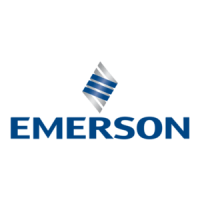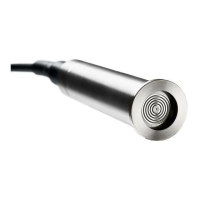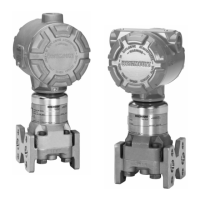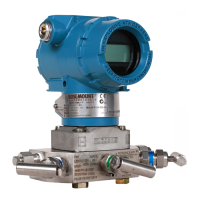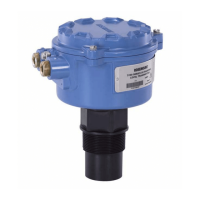Do you have a question about the Emerson Rosemount 1066 and is the answer not in the manual?
General safety instructions for installation, operation, and maintenance of Rosemount products.
Warning regarding explosion hazard and cleaning procedures.
Special conditions for safe use in hazardous areas related to electrostatic charge.
Tips for using the Quick Start screens for initial setup and configuration.
Instructions on how to return the transmitter to factory default settings.
Overview of the transmitter's features and its applications in various industries.
General technical specifications of the transmitter, including case, dimensions, and environmental ratings.
Details of intrinsic safety and non-incendive approvals for hazardous locations.
Specifications for the power supply and load requirements for HART communication.
Description of the transmitter's analog outputs and HART digital signal capabilities.
Details on pH and ORP measurement capabilities and their performance specifications.
Information on measuring conductivity using contacting sensors, including features and compensation options.
Details on measuring conductivity using toroidal sensors, including measurement choices and compensation.
Information on measuring chlorine, including free and total chlorine variants and compensation.
Information on measuring dissolved oxygen, including supported sensors and measurement units.
Information on measuring ozone, including supported sensors and compensation.
Information on ordering options, including measurement types, communication, and agency approvals.
Instructions for unpacking the instrument and inspecting its contents.
General guidelines for installing the transmitter, including environmental and mounting considerations.
Information on preparing and using the conduit openings for wiring connections.
Overview of wiring connections and accessibility.
Information on HART and FOUNDATION Fieldbus digital communication options.
Details on power supply and current loop wiring requirements for the 1066-HT model.
Wiring instructions for the two 4-20mA current outputs and their functions.
Power supply wiring considerations for the 1066-FF model.
Configuration and usage of FOUNDATION Fieldbus communication.
Instructions for wiring various sensor types to the main circuit board.
General procedures and requirements for all intrinsically safe installations.
Description of the transmitter's display, menu system, and interactive interface.
Explanation of the instrument's keypad layout and function keys.
Details on the main display screen, including process measurements and secondary values.
Overview of the menu structure and navigation using the instrument's keys.
General programming steps and functions available through the menu system.
Procedures for changing initial measurement type, units, and temperature settings.
How to select temperature units and compensation modes.
Guide to configuring and assigning values to the transmitter's analog current outputs.
Explains the purpose of security codes in preventing unwanted changes.
Details how security codes control access to menus and functions.
How to suspend current outputs for calibration or maintenance.
Overview of programming functions for desired measurement applications.
Describes how to configure the transmitter for pH measurements.
Describes how to configure the transmitter for ORP measurements.
Describes how to configure the transmitter for conductivity measurements.
Describes configuring the transmitter for toroidal conductivity measurements.
Steps to configure the transmitter for chlorine measurements.
Steps to configure the transmitter for total chlorine measurements.
Steps to configure the transmitter for monochloramine measurements.
Procedure for calibrating oxygen sensors.
Procedure for calibrating ozone sensors.
Explains the process of calibrating the transmitter to ensure accurate readings.
Procedure for performing automatic pH calibration using recognized buffer tables.
Procedure for manual pH calibration when non-standard buffers are used.
How to enter a known pH electrode slope value.
Process of matching transmitter readings to a second or referee instrument.
Automatic download of calibration data to SMART sensors.
Procedure for calibrating ORP or Redox measurements against a standard solution.
Methods for recalibrating a conductivity sensor after it has been in service.
Procedure for calibrating toroidal conductivity sensors.
Procedure for calibrating chlorine sensors.
Procedure for calibrating oxygen sensors.
Procedure for calibrating the temperature sensor offset.
Overview of HART communication capabilities and versions supported by the transmitter.
HART 5 device identification details for the 1066 transmitter.
HART 7 device identification details for the 1066 transmitter.
Details on physical installation and configuration of HART communication.
Toggling burst messages for HART 7 communication.
List of live measurements accessible via HART communication.
Information on diagnostics and status bits available through HART.
Overview of HART hosts and their capabilities.
Information on using the 475 Field Communicator for device access.
How to communicate wirelessly using the Smart Wireless THUM Adaptor.
Details on the Field Device Specification for HART implementation.
Status bits related to temperature measurement and potential errors.
Status bits specific to pH/ORP measurements and their meanings.
Status bits for conductivity measurements, including zero calibration and input range warnings.
Status bits for DO, Chlorine, and Ozone measurements.
Configuration parameters common across all 1066 transmitter models.
HART configuration parameters specific to pH/ORP measurements.
HART configuration parameters for contacting and toroidal conductivity transmitters.
HART configuration parameters for Ozone, Chlorine, and Dissolved Oxygen transmitters.
HART configuration parameters specific to Dissolved Oxygen measurements.
General procedures for expediting repair and return of instruments.
Procedure for returning instruments that are still under warranty.
Procedure for returning instruments that are no longer under warranty.
| Brand | Emerson |
|---|---|
| Model | Rosemount 1066 |
| Category | Transmitter |
| Language | English |

